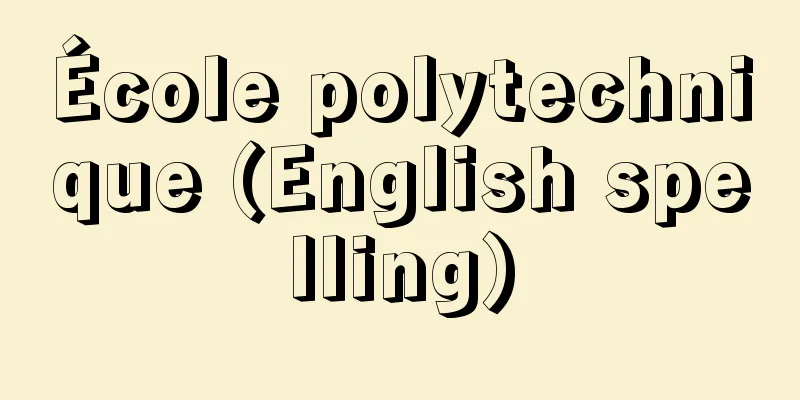Interferon - Interferon (English spelling)

|
It is also called virus-inhibiting factor. It was named in 1957 by Alick Isaacs (1921-67) and Jean Lindenmann (1924- ) as a substance that causes viral interference (suppression of viruses). It is abbreviated as IFN. Interferon is a small insoluble protein or glycoprotein that inhibits the growth (proliferation) of viruses. It is effective as one of the defense mechanisms against viral diseases in the host (the organism that the virus parasitizes). Infection with a virus or an inactive virus induces the synthesis and secretion of interferon in almost all animal cells, especially bone marrow cells, spleen cells, and cells of the reticuloendothelial system. Interferon inhibits the proliferation of not only the same type of virus that induced its synthesis, but also other viruses, and is rarely specific. However, the inhibitory effect is less in different host animal species than in the same species of animal cell, so it can be said that there is specificity for the animal species. Interferon synthesis in animal cells is induced by double-stranded RNA (ribonucleic acid), but not by other types of nucleic acid. Many RNA viruses create a double-stranded intermediate during replication, which gives them the ability to induce synthesis. On the other hand, DNA (deoxyribonucleic acid) viruses can also create double-stranded RNA in infected cells, which induces interferon synthesis in the host. However, interferon does not have a direct inhibitory effect on viral proliferation. It inhibits indirectly by inducing antiviral protein enzymes. This is evidenced by the fact that interferon induces the synthesis of antiviral protein enzymes not only in the cells where it is primarily synthesized, but also in the surrounding cells, widening the scope of its action. Currently, three types of this enzyme are known. (1) 2',5'-oligoadenylate synthetase (2',5'-A synthetase) is activated in the presence of double-stranded RNA and ATP (adenosine triphosphate) to produce 2',5'-oligoadenylate (2',5'-A), which then cleaves viral mRNA (messenger RNA). (2) Protein kinase: In the presence of double-stranded RNA and ATP, the enzyme is activated and phosphorylates the polypeptide chain initiator, blocking viral protein synthesis. (3) 2'-phosphodiesterase This enzyme cleaves the end of tRNA (transfer RNA), preventing the synthesis of viral proteins. There are four known types of interferon, depending on the cells that produce them: IFN-α (alpha), IFN-β (beta), IFN-γ (gamma), and IFN-ω (omega). IFN-α is derived from neutrophils and macrophages, and there are about 14 types. It is induced and produced by viral nucleic acids and bacterial endotoxins. It is said to have antiviral effects as well as tumor growth suppression effects. One type of IFN-ω is known, and is almost identical to IFN-α. IFN-β is produced by fibroblasts and epithelial cells, and has antiviral and antitumor effects, and only one type is known. IFN-γ is produced by T lymphocytes (T cells and NK cells), and is induced and produced by antigen cells and cytokines. It acts as an immunological control factor, such as activating macrophages, but has a weak antiviral effect. One type is known. Interferon is considered to be versatile for use in the prevention and treatment of various viral diseases through its antiviral effect. Currently, genetically engineered Escherichia coli is used to mass-produce interferon, and research is underway to mass-produce human interferon. [Masami Soneda] "The Latest Interferon Therapy" edited by Takakuwa Fumimaro and Kitamura Kiyoshi (1994, Chugai Igakusha)" ▽ "Interferon - The Progress of Research and the Possibility of Clinical Application" edited by Imanishi Jiro, supervised by Kishida Tsunataro (1998, Life Sciences)" ▽ "The Story of Interferon - The Life of a Scientist Devoted to Research" written by Kari Kantel, supervised by Kishida Tsunataro (2000, Minerva Shobo)" Source: Shogakukan Encyclopedia Nipponica About Encyclopedia Nipponica Information | Legend |
|
ウイルス抑制因子virus-inhibiting factorともいう。1957年アイザックスAlick Isaacs(1921―67)とリンデンマンJean Lindenmann(1924― )がバイラル・インターフェアランスviral interference(ウイルスの抑制)をおこす物質として命名。略称IFN。インターフェロンはウイルスの増生(増殖)を阻害する不溶性小型タンパク質または糖タンパク質である。そして宿主(しゅくしゅ)(ウイルスの寄生対象となる生物)のウイルス性疾患に対する防御作用の一つとして有効である。 ウイルスや不活性ウイルスによって感染がおこると、ほとんどすべての動物細胞、とくに骨髄(こつずい)細胞、脾(ひ)細胞、細網内皮系の細胞ではインターフェロンの合成や分泌が誘導される。インターフェロンは合成を誘導した同じタイプのウイルスだけでなく、ほかのウイルスの増生を阻止し、特異性を示すことが少ない。しかし、宿主動物の種が異なれば、同種の動物細胞よりは阻止効果が低下するため、動物の種には特異性があるといえる。動物細胞のインターフェロン合成は2本鎖RNA(リボ核酸)によって誘導され、その他の型の核酸では誘導されない。多くのRNAウイルスは複製の間に2本鎖中間体をつくるので、これによって合成誘導能をもつことになる。一方、DNA(デオキシリボ核酸)ウイルスも感染細胞内において、2本鎖RNAをつくることがあり、これが宿主にインターフェロン合成を誘導する。しかし、インターフェロンはウイルスの増生に対して直接の阻害作用をもつわけではない。抗ウイルスタンパク酵素を誘導することによって間接的に阻害をするのである。このことはインターフェロンが一次的に合成される細胞内だけでなく、周囲の細胞へも抗ウイルスタンパク酵素の合成を誘導し、作用範囲が広がることで証明される。現在、この酵素には3種が知られている。 (1)2',5'-オリゴアデニル酸合成酵素(2',5'-Aシンセターゼ) 2本鎖RNAとATP(アデノシン三リン酸)の存在により活性化され、2',5'-オリゴアデニル酸(2',5'-A)が生産され、これによりウイルス由来のmRNA(メッセンジャーRNA)を切断する。 (2)タンパク質リン酸化酵素 2本鎖RNAとATPの存在により、酵素が活性化されポリペプチド鎖開始因子がリン酸化され、ウイルスのタンパク質合成を阻止する。 (3)2'-フォスフォジエステラーゼ この酵素によって、tRNA(転移RNA)末端が切断され、ウイルスのタンパク質の合成を阻止する。 インターフェロンは産生する細胞により、IFN-α(アルファ)、IFN-β(ベータ)、IFN-γ(ガンマ)、IFN-ω(オメガ)の4種類が知られている。IFN-αは、好中球やマクロファージなど由来で、約14種がある。これはウイルスの核酸や細菌内毒素より誘発されつくられる。抗ウイルス作用のほか腫瘍(しゅよう)増殖抑制作用などがあるといわれる。IFN-ωは、IFN-αとほぼ相同である、1種類が知られている。IFN-βは繊維芽細胞や上皮細胞などでつくられ、抗ウイルス効果や抗腫瘍効果などがあり、1種類だけ知られている。IFN-γはTリンパ球(T細胞やNK細胞)でつくられ、抗原細胞やサイトカイシンなどにより誘発され産生される。マクロファージを活性化するなど免疫学的制御因子として働くが、抗ウイルス作用は弱い。1種類が知られている。 インターフェロンは抗ウイルス作用を通じて各種ウイルス疾患の予防や治療に使用する万能性が考えられている。現在は大量生産するために、遺伝子工学を利用した大腸菌を使い、さらに、ヒトインターフェロンの大量生産に向けて研究が進められている。 [曽根田正己] 『高久史麿・北村聖編著『最新インターフェロン療法』(1994・中外医学社)』▽『岸田綱太郎総監修、今西二郎編『インターフェロン――その研究の歩みと臨床応用への可能性』(1998・ライフ・サイエンス)』▽『カリ・カンテル著、岸田綱太郎監訳『インターフェロン物語――研究にかけたある科学者の人生』(2000・ミネルヴァ書房)』 出典 小学館 日本大百科全書(ニッポニカ)日本大百科全書(ニッポニカ)について 情報 | 凡例 |
Recommend
Soul music (English spelling)
Contemporary African-American popular music that p...
gille
In France, for example, in Molière's Don Juan...
Sakuma Kasegi
In the Edo period, farming was a way of earning mo...
Vladivostok (English spelling) Владивосток/Vladivostok
It is the administrative center of Primorsky Krai...
Xie Lingyun - Shareiun
A poet from the Southern Song Dynasty in China. B...
Wig wrap - Katsuramaki
...The wig belts used with the Noh masks of medie...
Crucifixion Mozaemon
A legendary righteous man from the early modern p...
Laticauda colubrina (English spelling)
… [Takahiro Matsui]. … *Some of the terminology t...
Binomial distribution
Let p be the probability that event E occurs in a...
Insect mound - Mushizuka
There are various reasons for erecting insect moun...
Merimde (English spelling)
Located in northern Egypt, about 60 km northwest o...
Mirror hanging - Kagamikake
1 Same as “mirror stand.” 2. A cloth to cover the ...
《Skinned Dog》 - A dog wearing a coat
…Already in his collection of poems, The Orators ...
Karadou-buro (copper stove)
...The understanding of the tea ceremony is that ...
Rama [I] - Rama
The founder of the Rattanakosin Dynasty (Bangkok D...









